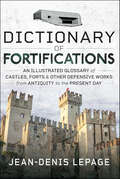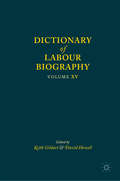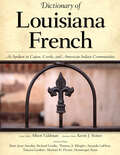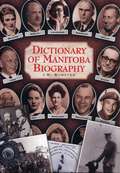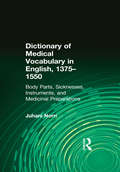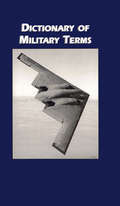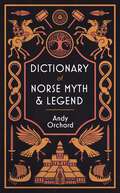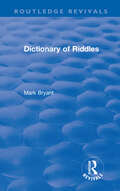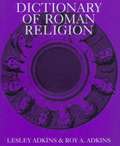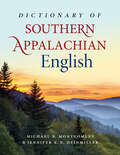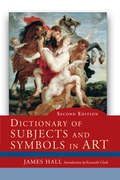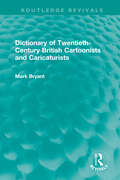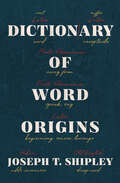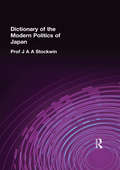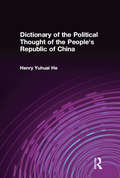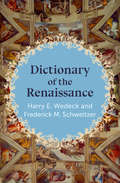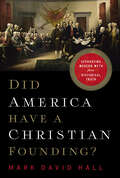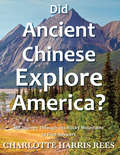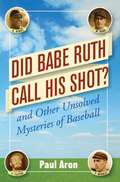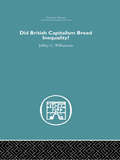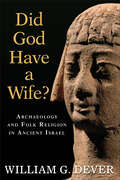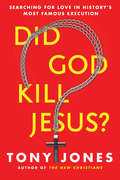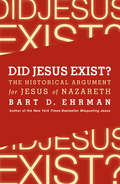- Table View
- List View
Dictionary of Fortifications: An Illustrated Glossary of Castles, Forts, & Other Defensive Works from Antiquity to the Present Day
by Jean-Denis LepageThis Dictionary of Fortifications is an attractive and convenient reference for anyone with an interest in castles, forts, walled cities and any other defensive architecture, including temporary structures, of any period. The heart of the book is a useful glossary of over 1,200 terms relating to fortifications through the ages. Drawn from many languages besides English, each has at least a concise definition or description, while more significant entries take the form of short articles. Many are accompanied by a clear sketch, diagram, cross-section, floor plan or map skillfully executed by the author himself. In all, there are over 400 of these black and white illustrations. Although the glossary is organized alphabetically (from Abatis to Zwischenwiderstandnet), cross references allow the reader to easily follow themes of interest through the book. Buttressing the glossary there is a section giving an overview of the historical development of fortifications from prehistory to the present day. A further chapter outlines the concomitant development of siege warfare over the same long span, detailing the evolution of siege engines and other tactics used to overcome fortifications. This is a fascinating reference for anyone with the slightest interest in military architecture.
Dictionary of Labour Biography: Volume XV
by David Howell Keith GildartThe Dictionary of Labour Biography has an outstanding reputation as a reference work for the study of nineteenth and twentieth century British history. Volume XV maintains this standard of original and thorough scholarship. Each entry is written by a specialist drawing on an array of primary and secondary sources. The biographical essays engage with recent historiographical developments in the field of labour history. The scope of the volume emphasises the ethnic and national diversity of the British labour movement and neglected political traditions.
Dictionary of Louisiana French: As Spoken in Cajun, Creole, and American Indian Communities
by Barry Jean Ancelet Richard Guidry Thomas A. Klingler Amanda LaFleur Tamara Lindner Michael D. Picone Dominique RyonThe Dictionary of Louisiana French (DLF) provides the richest inventory of French vocabulary in Louisiana and reflects precisely the speech of the period from 1930 to the present. This dictionary describes the current usage of French-speaking peoples in the five broad regions of South Louisiana: the coastal marshes, the banks of the Mississippi River, the central area, the north, and the western prairie. Data were collected during interviews from at least five persons in each of twenty-four areas in these regions. In addition to the data collected from fieldwork, the dictionary contains material compiled from existing lexical inventories, from texts published after 1930, and from archival recordings. The new authoritative resource, the DLF not only contains the largest number of words and expressions but also provides the most complete information available for each entry. Entries include the word in the conventional French spelling, the pronunciation (including attested variants), the part of speech classification, the English equivalent, and the word's use in common phrases. The DLF features a wealth of illustrative examples derived from fieldwork and textual sources and identification of the parish where the entry was collected or the source from which it was compiled. An English-to-Louisiana French index enables readers to find out how particular notions would be expressed in la Louisiane.
Dictionary of Manitoba Biography
by J.M. BumstedManitoba has been at the crossroads of many of the important debates and events in Canadian history. From the early fur trade to the Riel Rebellion to the Winnipeg General Strike, Manitobans have frequently played crucial roles in Canadian and sometimes world history. Until now, there has been no comprehensive, contemporary source for information on the many Manitobans who have left their mark on history and society. Dictionary of Manitoba Biography fills this gap, with biographical sketches of over 1700 Manitobans who have made an impact in politics, the arts, sports, commerce, agriculture, and society. It is an invaluable resource for scholars, students, and general readers interested in Canadian history. Particular emphasis has been placed on reflecting Manitoba's ethnic and social diversity, and on including men and women who were notable in their own day but have now been forgotten. Many entries also refer the reader to additional references for further reading. More than a reference book, Dictionary of Manitoba Biography is also a fascinating work of history in its own right, which presents the full and colourful scope of over 300 years of people in Manitoba history and social life, from premiers and mayors to nightclub owners and sports heroes.
Dictionary of Medical Vocabulary in English, 1375–1550: Body Parts, Sicknesses, Instruments, and Medicinal Preparations
by Juhani NorriMedical texts written in English during the late Middle Ages have in recent years attracted increasing attention among scholars. From approximately 1375 onwards, the use of English began to gain a firmer foothold in medical manuscripts, which in previous centuries had been written mainly in Latin or French. Scholars of Middle English, and editors of medical texts from late medieval England, are thus faced with a huge medical vocabulary which no single volume has yet attempted to define. This dictionary is therefore an essential reference tool. The material analysed in the Dictionary of Medical Vocabulary in English, 1375–1550 includes edited texts, manuscripts and early printed books, and represents three main types of medical writing: surgical manuals and tracts; academic treatises by university-trained physicians, and remedybooks. The dictionary covers four lexical fields: names of sicknesses, body parts, instruments, and medicinal preparations. Entries are structured as follows: (1) headword (2) scribal variants occurring in the texts (3) etymology (4) definition(s), each definition followed by relevant quotations (5) references to corresponding entries in the Dictionary of Old English, Middle English Dictionary, and The Oxford English Dictionary (6) references to academic books and articles containing information on the history and/or meaning of the term.
Dictionary of Military Terms: Over 6,000 Words Clearly Defined (Dictionaries Ser.)
by Richard BowyerFirst Published in 2000. Routledge is an imprint of Taylor & Francis, an informa company.
Dictionary of Norse Myth & Legend
by Andrew OrchardFrom Loki to Thor, Ragnarok to BeowulfA gripping and truly mesmerising delve into the Norse legendsFrom bestselling books to blockbusting Hollywood movies, the myths of the Scandinavian gods and heroes are part of the modern day landscape.For over a millennium before the arrival of Christianity, the legends permeated everyday life in Iceland and the northern reaches of Europe. Since that time, they have been perpetuated in literature and the arts in forms as diverse as Tolkien and Wagner, graphic novels to the world of Marvel. This book covers the entire cast of supernatural beings, from gods to trolls, heroes to monsters, and deals with the social and historical background to the myths, topics such as burial rites, sacrificial practices and runes.
Dictionary of Norse Myth & Legend
by Andrew OrchardFrom Loki to Thor, Ragnarok to BeowulfA gripping and truly mesmerising delve into the Norse legendsFrom bestselling books to blockbusting Hollywood movies, the myths of the Scandinavian gods and heroes are part of the modern day landscape.For over a millennium before the arrival of Christianity, the legends permeated everyday life in Iceland and the northern reaches of Europe. Since that time, they have been perpetuated in literature and the arts in forms as diverse as Tolkien and Wagner, graphic novels to the world of Marvel. This book covers the entire cast of supernatural beings, from gods to trolls, heroes to monsters, and deals with the social and historical background to the myths, topics such as burial rites, sacrificial practices and runes.
Dictionary of Riddles (Routledge Revivals)
by Mark BryantOriginally published in 1990 by Routledge, Dictionary of Riddles is a collection of nearly 1500 of the most cryptic and entertaining riddles from history. Drawn from sources throughout the world, the collection ranges from earthy medieval jokes about fleas, worms and vegetables to the sophisticated puzzles composed by literary figures from Schiller, Swift, Voltaire, Rousseau and Cervantes to Edgar Allan Poe, Lewis Carroll and J.R.R. Tolkien. The book traces the history of riddles from their origins in antiquity through the golden age of the Renaissance, to their decline into the nursery and the first few signs of their modern revival, and draws together all the strands of the riddling art. Dictionary of Riddles received a Special Commendation in Reference Review’s Best Specialist Reference Books of 1990 Awards.
Dictionary of Roman Religion
by Lesley Adkins Roy A. AdkinsBreaking with the long tradition of presenting classical Roman mythology as a reworked and diluted version of its Greek counterpart, offers entries ranging from short definitions to short essays on both the primitive, native aspects and the cosmopolitan fertility of mythology incorporated from Judaism, Druidism, Mithraism, and other cultures. Includes deities and their kin, festivals, events, writers, places and buildings, cult objects, burial rites, and other aspects. Well cross-referenced, and most entries are referenced to the bibliography. Includes a glossary without pronunciation. Annotation c. by Book News, Inc., Portland, Or.
Dictionary of Southern Appalachian English
by Michael B. Montgomery & Jennifer K. N. HeinmillerThe Dictionary of Southern Appalachian English is a revised and expanded edition of the Weatherford Award–winning Dictionary of Smoky Mountain English, published in 2005 and known in Appalachian studies circles as the most comprehensive reference work dedicated to Appalachian vernacular and linguistic practice. Editors Michael B. Montgomery and Jennifer K. N. Heinmiller document the variety of English used in parts of eight states, ranging from West Virginia to Georgia—an expansion of the first edition's geography, which was limited primarily to North Carolina and Tennessee—and include over 10,000 entries drawn from over 2,200 sources. The entries include approximately 35,000 citations to provide the reader with historical context, meaning, and usage. Around 1,600 of those examples are from letters written by Civil War soldiers and their family members, and another 4,000 are taken from regional oral history recordings. Decades in the making, the Dictionary of Southern Appalachian English surpasses the original by thousands of entries. There is no work of this magnitude available that so completely illustrates the rich language of the Smoky Mountains and Southern Appalachia.
Dictionary of Subjects and Symbols in Art (Icon Editions Ser.)
by James HallThe understanding and enjoyment of a work of art depends as much on the story it depicts as on the artist's execution of it. But what were once biblical or classical commonplaces are not so readily recognizable today. This book relates in a succinct and readable way the themes, sacred and secular, on which the repertoire of Western art is based. Combined here in a single volume are religious, classical, and historical themes, figures of moral allegory, and characters from romantic poetry that appeared throughout paintings and sculpture in Western art before and after the Renaissance. More than just a dictionary, this text places these subjects in their narrative, historical, or mythological context and uses extensive cross-referencing to enhance and clarify the meanings of these themes for the reader. The definitive work by which others are compared, this volume has become an indispensable handbook for students and general appreciators alike. This wholly redesigned second edition includes a new insert of images chosen by the author, as well as a new preface and index to highlight the ideas, beliefs, and social and religious customs that form the background of much of this subject matter.
Dictionary of Twentieth-Century British Cartoonists and Caricaturists (Routledge Revivals)
by Mark BryantBritish cartoonists and caricaturists are renowned worldwide. Originally published in 2000, this indispensable handbook offers a unique ‘who’s who’ of all the major artists working in Britain in the twentieth century and contains nearly 500 entries. Extensively illustrated, the book provides information on the work of artists such as Steve Bell, Gerald Scarfe, Posy Simmonds, Ronald Searle, Trog, mac and Larry as well as such past masters as David Low, Vicky, H. M. Bateman, Illingworth, Heath Robinson and more. The dictionary concentrates primarily on political cartoonists, caricaturists and joke or ‘gag’ cartoonists, actively working for the main Fleet Street national dailies and weeklies from 1900 to 1995. Each entry is cross-referenced and provides a concise biographical outline with an account of the artist’s style, influences and preferred medium. Where relevant the entry includes suggestions for further reading and notes solo exhibitions, books illustrated and works held in public collections. The Dictionary of Twentieth-Century British Cartoonists and Caricaturists offers an insight into the lives of satirical artists working during a century that provoked cartoonists and caricaturists to a pitch of comic and artistic invention that has rarely been matched.
Dictionary of Word Origins (Barnes And Noble Digital Library)
by Joseph T ShipleyThis extensive reference volume presents the etymological history of thousands of English words. The story of how words come to be is the story of how humans think, and how we fashion our civilizations. Words can be the product of long and intertwining histories, migrations from other languages, or new coinages of science or slang. This diversity of origins is part of what gives the English language its beauty and power. In Dictionary of Word Origins, etymologist Joseph T. Shipley provides a fascinating window into the evolution of modern English, from the onomatopoetic aspect of &“abash&” to the animalistic origins of &“zodiac.&”
Dictionary of the Modern Politics of Japan
by Prof J Stockwin J. A. StockwinThe politics of Japan are less widely reported than its economics. Most people are aware of the economic 'miracle' following the Second World War, whereby Japan became the second largest economy in the world after the United States, and the economic stagnation of the early 1990s is also well known. But it is difficult to make sense of these phenomena without a knowledge of the political system and the ways in which it works in practice. Containing an introductory essay, an essay on theories of Japanese politics and over 250 A-Z entries, the Dictionary of the Modern Politics of Japan remedies this imbalance, and answers the need for an accessible work of reference bringing together information and authoritative analysis on all aspects of the politics of Japan and the Japanese political system.Including a fully annotated bibliography to guide the user to further reading, the entries are thoroughly cross-referenced and indexed, and are supplemented with maps and tables, to ensure that the Dictionary of the Modern Politics of Japan is essential reading for all scholars and students of the politics and international relations of Japan.
Dictionary of the Political Thought of the People's Republic of China
by Henry Yuhuai HeFar more than a simple glossary, this unique resource provides a detailed lexicography of political and social life in China today, and deepens our understanding of the last twenty years of enormous change in the People's Republic. Each of the 1,600 entries (1) is rendered in Chinese characters; (2) is alphabetized according to pinyin, the Chinese phonetic alphabet; (3) is translated into English; and (4) is explained in terms of the situation in which it first appeared and how its meaning shifted over time. In addition to the main body of definitions and annotations, there are three appendices, abbreviations, a name index, and a bibliography.
Dictionary of the Renaissance
by Frederick M. Schweitzer Harry E. WedeckThis A-to-Z reference offers a survey of Renaissance personalities, innovations, and other terminologies with an in-depth introduction about the period.By the fourteenth century, Italian society bore little resemblance to that of the feudal age. Merchants and financiers were establishing a new social order with greater freedom than their counterparts north of the Alps. This meant that cultural transformations would first flourish in Italy and later be carried to the rest of the continent.Dictionary of the Renaissance is a comprehensive reference guide to the period, including informative entries about major artists and other important figures, significant events and locations, and other key terms and concepts associated with the Renaissance. The introduction provides a historic overview of the cultural, political, economic, and scientific transformations that occurred in Italy between the fourteenth and seventeenth centuries.
Did America Have a Christian Founding?: Separating Modern Myth from Historical Truth
by Mark David HallA distinguished professor debunks the assertion that America's Founders were deists who desired the strict separation of church and state and instead shows that their political ideas were profoundly influenced by their Christian convictions.In 2010, David Mark Hall gave a lecture at the Heritage Foundation entitled "Did America Have a Christian Founding?" His balanced and thoughtful approach to this controversial question caused a sensation. C-SPAN televised his talk, and an essay based on it has been downloaded more than 300,000 times.In this book, Hall expands upon this essay, making the airtight case that America's Founders were not deists. He explains why and how the Founders' views are absolutely relevant today, showingthat they did not create a "godless" Constitution;that even Jefferson and Madison did not want a high wall separating church and state;that most Founders believed the government should encourage Christianity; andthat they embraced a robust understanding of religious liberty for biblical and theological reasons.This compelling and utterly persuasive book will convince skeptics and equip believers and conservatives to defend the idea that Christian thought was crucial to the nation's founding--and that this benefits all of us, whatever our faith (or lack of faith).
Did Ancient Chinese Explore America
by Charlotte Harris ReesA Chinese classic, the Shan Hai Jing, reportedly from 2000 BC claimed travels to the ends of the earth. However, today many, while accepting the antiquity of this account, believe it was just mythology. But was it?Testing the hypothesis that the Shan Hai Jing described actual surveys of North America, Charlotte Harris Rees, author of books about early Chinese exploration, followed an alleged 1100 mile Chinese trek along the eastern slope of the US Rocky Mountains. The Chinese account should have been easy to disprove. In the travelogue Did Ancient Chinese Explore America? Rees candidly shares her initial doubts then her search and discoveries. She weaves together history, subtle humor, academic studies, and many photographs to tell a compelling story.
Did Babe Ruth Call His Shot? And Other Unsolved Mysteries of Baseball
by Paul Aron"Ruth did not point at the fence before he swung," Root insisted. "If he had made a gesture like that, well, anybody who knows me knows that Ruth would have ended up on his ass." What really happened? That's the question this book asks, not just about Ruth's called shot but also about Ed Delahanty's death and Moe Berg's spying and Satchel Paige's age and Fidel Castro's tryout. This is not the place to find out who the best first basemen were or what were the greatest teams or whether Pete Rose or Joe Jackson belong in the Hall of Fame. Those are important and fascinating issues, well worth discussing. But whatever your opinion on these issues, it's undeniably a matter of opinion. Here, instead, are the facts.
Did British Capitalism Breed Inequality? (Economic History Ser.)
by Jeffrey G. WilliamsonFirst Published in 2005. This thirteen-chapter title is divided into three parts and concludes with five appendices, references, and index. The first part focuses on income inequality and the historical state of wages. The second begins the discussion on the driving forces of economic inequality and equilibrating factors. The third provides a model for inequality in a resource-scarce open economy with data, theory, and debate. Appropriate for economic students and those interested in British economic history.
Did God Have a Wife?: Archaeology and Folk Religion in Ancient Israel
by William G. DeverFollowing up on his two recent, widely acclaimed studies of ancient Israelite history and society, William Dever here reconstructs the practice of religion in ancient Israel from the bottom up. Archaeological excavations reveal numerous local and family shrines where sacrifices and other rituals were carried out. Intrigued by this "folk religion" in all its variety and vitality, Dever writes about ordinary people in ancient Israel and their everyday religious lives.Did God Have a Wife? shines new light on the presence and influence of women's cults in early Israel and their implications for our understanding of Israel's official "Book religion." Dever pays particular attention to the goddess Asherah, reviled by the authors of the Hebrew Bible as a foreign deity but, in the view of many modern scholars, popularly envisioned in early Israel as the consort of biblical Yahweh. His work also gives new prominence to women as the custodians of Israel's folk religion.The first book by an archaeologist on ancient Israelite religion, this fascinating study critically reviews virtually all of the archaeological literature of the past generation, while also bringing fresh evidence to the table. Though Dever digs deep into the past, his discussion is extensively illustrated, unencumbered by footnotes, and vivid with colorful insights. Meant for professional and general audiences alike, Did God Have a Wife? is sure to spur wide and passionate debate.
Did God Kill Jesus?: Searching for Love in History's Most Famous Execution
by Tony JonesThe theologian and author of The God of Wild Places dispels the angry God narrative of crucifixion in this uplifting and accessible book.Many Christians believe that God the Father demanded his only Son die a cruel, gruesome death to appease His wrath, since humanity is so irredeemably sinful and therefore repugnant to God. Tony Jones, popular progressive Christian blogger, author, and scholar, argues that this understanding is actually a medieval invention and not what the Bible really teaches. In Did God Kill Jesus?, Jones looks beyond medieval convictions to reframe how we see Jesus's death. Christians today must transcend the shame and guilt that have shaped conceptions of the human soul and made us fearful of God, and replace them with love, grace, and joyfulness, which better expresses what the cross is really about.How we understand the cross reflects directly what kind of God we worship. By letting go of the wrathful God who cannot stand to be in our presence unless he pretends to see Jesus in our place, we discover the biblical God who reaches out to love and embrace us while "we were yet sinners." Jones offers a positive, loving, inclusive interpretation of the faith that is both challenging and inspiring.
Did It All Start With A Snowball Fight?: And Other Questions About... The American Revolution (Good Question! Series)
by Mark Elliott Robert Hunt Mary Kay CarsonCould a snowball fight really have sparked the American Revolution? What made people get so steaming mad over the price of tea? And did it take a minuteman only a minute to join the fight? <P><P>Step back into colonial America to find out about taxation without representation; why the British were called lobsters, the first-ever combat submarine, and whether Yankee doodles were really dandy! <P><P>This interesting take on eh American Revolution will attract young readers...even if they don't have to write a book report.
Did Jesus Exist?
by Bart D. EhrmanFor years Bart Ehrman has been routinely bombarded with one question: Did Jesus Exist? As a leading Bible expert, fans and critics alike have sent letters, emails, posted blogs, and questioned Ehrman during interviews wanting his opinion about this nagging question that has become a conspiracy theorist cottage industry the world over. The idea that the character of Jesus was an invention of the early church-and later a tool of control employed by the Roman Catholic Church-is a widely held belief and Ehrman has decided it's time to put the issue to rest. Yes, the historical Jesus of Nazareth did exist. Known as a master explainer with deep knowledge of the field, Ehrman methodically demolishes both the scholarly and popular "mythicist" arguments against the existence of Jesus. Marshaling evidence from within the Bible and the wider historical record of the ancient world, Ehrman tackles the key issues that surround the popular mythologies associated with Jesus and the early Christian movement. Throughout Did Jesus Exist? Ehrman establishes the criterion for any genuine historical investigation and provides a robust defense of the methods required to discover the Jesus of history. Those committed to the "non-existence" theory will need to read this formidable scholar's counter argument while the more traditionally minded will enthusiastically support Ehrman's definitive answer to the question. Perfect for the vigorous online debating community, this eBook original will be a must read for anyone interested in Jesus, the Bible, and the birth of Christianity.
